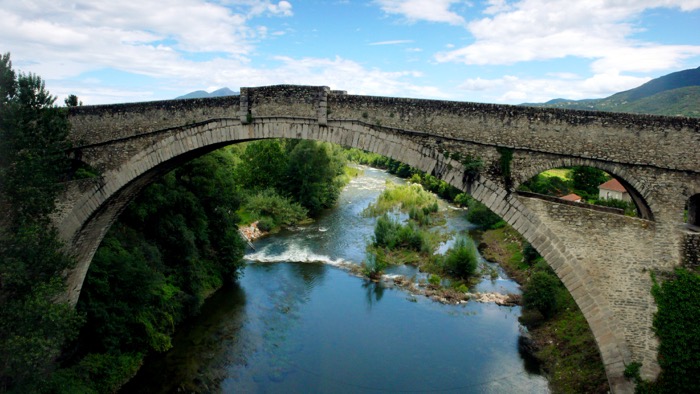Céret is the undisputed cherry capital of the P-O, and probably the whole of France, its cherry trees the last of the spring fruits to blossom but the first to bear fruit. By May, the first cherries of the season are on their way to the President of France, and stalls, trestle tables, and rickety makeshift benches laden with the fruit appear on every street corner, in garages, lay-bys and the Saturday market.

These early fruits are usually not cheap – but they splash vivid colour around Céret and bring with them the feel of early summer.
Don’t miss the Fête de la Cerise, a colourful weekend of stone spitting, music, dancing and entertainment in the streets, not to mention the inventive recipes involving cherries served up in the local restaurants…. Or why not try a glass of cherry beer, cherry wine, cherry pie, cherry pasty, cherry burger, cherries on toast, cherries with spam……..?
The weekly market, held every Saturday morning beneath the hundred-year-old plane trees that line the streets of the town centre, is one of the best in the area. Like the first cherries, it’s not cheap, but locals and tourists alike are drawn by the very ‘Frenchness’ of it, the smells and sounds as the strains of accordion or jazz mingle in the warm southern air with artisan made goat’s cheese and paella ‘à emporter’, and the café trottoirs overflow with people watchers.
 |  |
 |  |
The old ramparts, the grand city gates, the Place des Neuf Jets with its attractive fountain and choice of cafes and restaurants, the narrow, cobbled streets, all make Céret a delightful town through which to stroll – and a magnet for artists.
In 1911, Picasso and Braques arrived in Céret and began experimenting with Cubism, a painting style that was to revolutionise art. Other artists were drawn to the town, discussions held in the Grand Café were animated, and Céret became a popular meeting place for artists from far and wide.
Juan Gris went on to create The Musée d’Art Moderne de Céret in 1950, a permanent collection of both internationally famous and local artists, including 78 pieces by Picasso – 57 of which were gifts of the artist. Each summer, it stages an impressive exhibition, often the work of famous 20th century artists who were influenced by a sojourn there. Not only Picasso and Braques but Matisse, Gris, Max Jacob, Marquet, Maillol, Manolo, Chagall, Dufy, Miro and Dali have all fallen under the charm of this gentle Catalan town. Watch out for a Dali special this summer.
Music is also well catered for in Céret with the Musée des Instruments.

Have you ever seen a percussion instrument made out of the lower jawbone of a donkey, teeth still intact, with a little wooden stick to bump along the teeth? Or how about a silver- and jewel-encrusted horn-trumpet conch shell from a Tibetan Buddhist monastery? This small but innovative and eclectic museum looks at instruments from all over the world.
Three bridges span the Tech in Céret, one of which, Le Pont du Diable, was supposedly built by the devil in 1321 in exchange for the soul of the first Cérétan to cross. The crafty engineer sent a cat across first, but it nevertheless took the wary locals many years to use the bridge happily.
Find out everything you need to know about Céret at the newly relocated Tourist Office in the Rue Ferreol, with seating for visitors, tablets to surf and a cellphone charging station where you can plug in your phone, head off to lunch, and return later to retrieve it fully charged.
And don’t forget to check out the fabulous walks and amazing views in the Céret area, including the “Chemin Sublime” a town trail which highlights some of the attractive architecture painted by Picasso, Dufy, and Soutine, with reproductions of the paintings next to the buildings.

Sit in the shade of the ancient plane trees on a sunny day with ‘un grand crème’ or a cold beer and drink in the extraordinary charm and character of this rather special little Mediterranean town.


